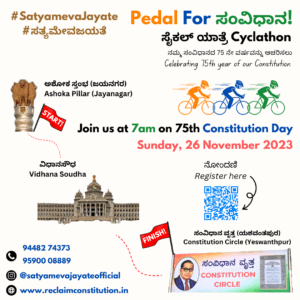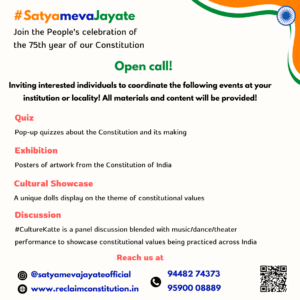Vinay Kumar and his team are gearing up to celebrate the 75th anniversary of the Constitution of Day in Bengaluru.

26 November is celebrated as Constitution Day in India. (Supplied)
“Can you ask for anything better than a people’s celebration of a Constitution that begins with “We, the people”?” asks Bengaluru-based aerospace engineer Vinay Kumar. In his attempt to make people aware of the constitutional values, Kumar launched the Reclaim Constitution initiative on 26 January, 2023.
Using copies of artwork from the Constitution and quotes from the Constituent Assembly debates, Kumar and his team — of team has doctors, scientists and designers — created postcards and distributed them around the streets of Bengaluru.
But this wasn’t enough, he realised. So he embarked on a cultural route to spread the wisdom behind the constitutional values. For Navaratri 2023 celebrations, Kumar commissioned artworks of the Founding Mothers of the Constitution of India to be included as Golu dolls across community celebrations.

The event will commence at 7 am at Ashoka Pillar in Jayanagar and end at Constitution Circle in Yeshwantpur. (Supplied)
Following the success of this, Kumar and his team are now gearing up to celebrate the 75th anniversary of the Constitution of Day in Bengaluru.
To honour this day, on 26 November 2023, Kumar’s team has organised a cyclathon called Pedal For ಸಂವಿಧಾನ (Constitution). The event will commence at 7 am at Ashoka Pillar in Jayanagar and end at Constitution Circle in Yeshwantpur.
“We also have planned a blood donation camp. Blood donation vans will be stationed at Ashoka Pillar and Constitution Circle from 10 am to 3 pm,” he shares.
Kumar, however, is hopeful to take this beyond the state borders. His team has made an open call to any individual, who can lead the celebrations of the 75th year at their institution or neighbourhood, at any time till 26 January, 2025.
The government, both state and central, were enthusiastic about celebrating the 75th year of Independence. However, they lacked a similar sentiment to celebrate the 75th year of the birth of the Constitution of India, Kumar rues.
“We have deposited our inherent rights with the state to form this Constitution. And this, with the expectation that it will enhance those rights and protect our freedoms. Our academic systems have failed to impart this notion to the masses. This is one of the root causes for the general apathy towards wider participation in constitutional processes,” insists Kumar.
There is an urgent need to find newer ways to celebrate the Constitution and improve public engagement with the Constitution, or “we stand to lose this precious inheritance,” he adds.
The Constitution of India was adopted on 26 November, 1949 as mentioned in the Preamble to the Constitution. Referring to author Akash Singh Rathor’s book, Ambedkar’s Preamble, Vinay quotes, “In 1929, a call was made for complete independence, or purna Swaraj, in defiance of the offer of dominion status that the British government had put forth. Jawaharlal Nehru had declared, ‘Complete independence is our motto’. A year later, Mahtama Gandhi published an article on 26 January, 1930. It read, ‘Today is the day to proclaim that we will not be satisfied with dominion status; we want purna Swaraj, or complete independence.'”
This bold and defiant move began to be recognised, and routinely celebrated, on 26 January as Purna Swaraj Diwas. As a callback to this significant demand, the Constituent Assembly determined that the new Constitution, Preamble and all, would come into complete effect on 26 January 1950.
Kumar hopes to garner youth participation so that they ditch being bystanders and realise its true worth. But this, he understands, has to begin at the grassroots level. His team has designed various templates for student engagement like quizzes, art exhibitions, cultural performances and panel discussions.
“We are inviting academic institutions across the country. We want them to make use of these templates to introduce the Constitution to the youth in newer and meaningful ways,” he tells South First.
But, what about the values envisaged by the builders of independent India? Has India made any progress?
“In the words of Annie Mascarene (freedom fighter and one of 15 women members of the Constituent Assembly) — “This is the first instance when heterogeneous interests in a continent state like India have united themselves to form a homogeneous unit to lay down rules and regulations that should lead us or guide us in future to live a national life.”
“That our diverse county has been held together for seven decades by this Constitution is proof of the strong foundations laid by its founding mothers and fathers,” he elaborates.
Although it was never a perfect Constitution, the founders left it for us, the future generations, with the responsibility of taking it on a path of eternal improvement, he notes. While positive strides have been made, the founding values of our Republic have been tested by all political parties alike, Kumar shares.

Vinay Kumar and his team are running a campaign to increase voter registration in the age group of 18-28 years. (iStock)
“We are in the vicinity of the most important general elections (Lok Sabha 2024) of modern India. The outcome of Lok Sabha 2024 can make or break our Constitution, the one envisaged by the builders of independent India.
Based on a recent data released by ECI for Maharashtra, Kumar shares that the 18-19 age group is 3.7% of the total population. But, it’s only 0.3% of the voters’ list as of October 2023. This means that more than 90% of that age group in Maharashtra haven’t registered to vote.
The 20-29 age group are almost a quarter of our population. However, only 12.3% of them are on the voters’ list. The numbers aren’t very different in other states. To give a boost to these numbers, Kumar and his team are running a campaign to increase voter registration in the age group of 18-28 years.
“The campaign will begin this weekend and end on 9 December 2023, which is the last date for vote registration for Lok Sabha 2024. We will be conducting online voter registration training sessions. There are plans to distribute pamphlets outside colleges to urge students to register for voting,” he shares.

The call is open to any individual, who can lead the celebrations of the 75th year at their institution or neighbourhood, at any time till 26 January, 2025. (Supplied)
The debates in the Constituent Assembly and the speeches in the Parliament back then held great merit in firming this visionary Constitution. But more recently, debates have been reduced to mere mudslinging, leaving no room for the interest of democracy or the people.
“Look at what heights we have fallen from. Today most parliamentarians are shining examples of the adage — Politics is the last resort for the scoundrel. It is indeed painful to see the abysmal quality of debates and woefully poor attendance records of parliamentarians. But, all is not lost yet. The youth of the country are the only hope,” he explains.
The Constitution has been amended 105 times. It started with 395 Articles and 8 Schedules, and now stands at more than 450 Articles and 12 Schedules. But how many Indian youth are aware?

Blood donation vans will be stationed at Ashoka Pillar and Constitution Circle from 10 am to 3 pm. (Supplied)
The median age of India is around 26 years now. There is a hope of finding young Indians who can grasp the situation and rise to the occasion to reclaim the constitution from a bunch of old men who have repeatedly failed us, notes Kumar.
“As Hansa Mehta (freedom fighter and one of 15 women members of the Constituent Assembly) said, “On the floor of this House and even outside questions have been asked whether the Constitution is good and how long it is going to last. It is very difficult to reply to this question. The goodness or badness of a Constitution depends on how it is going to work. If it works in the interests of the people, it will be a good Constitution; if it works otherwise, it will be a bad Constitution. It is for the future electors to elect the right kind of persons, who will work the Constitution in the interests of the people. The responsibility, therefore, lies with the people,” he quotes.
With intent at the core of his passion to educate the youth about constitutional values, Kumar remains hopeful that the effort of his team will be that proverbial drop in the ocean.
To participate in their events or for more information, click www.reclaimconstitution.in, email – mail@reclaimconstitution.in, call 94482 74373 / 95900 08889

Jul 26, 2024

Jul 21, 2024

Jul 20, 2024

Jul 20, 2024

Jul 19, 2024

Jul 18, 2024